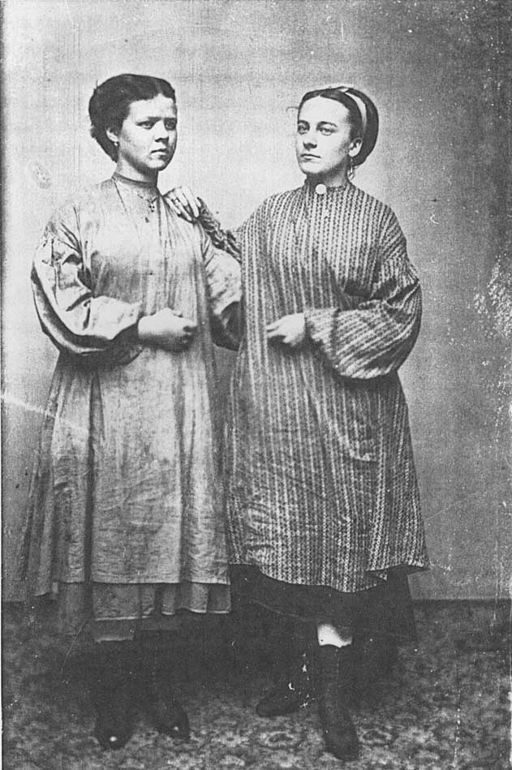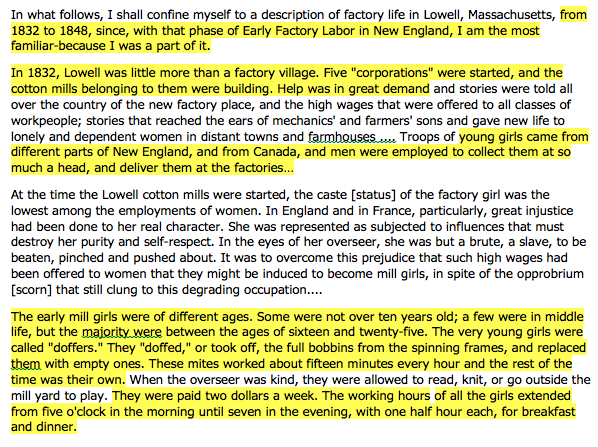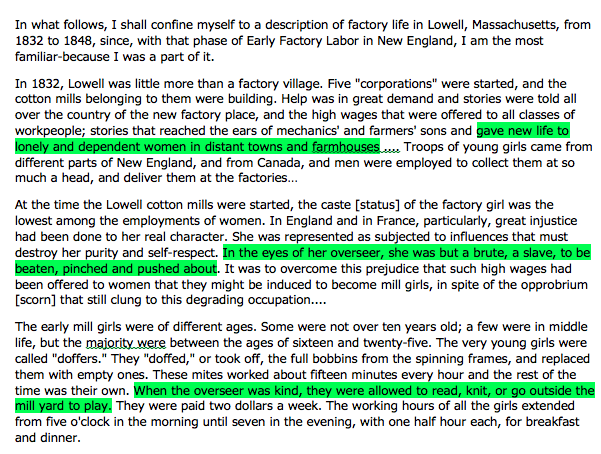Learn It
In this activity you will learn how to distinguish between fact, opinion and reasoned judgment. In order to do this, you need a working definition of each of these three concepts.
A fact is something that is known to be true, or something known to have happened. For example, women who went to work in the Lowell factories were known as "mill girls."
An opinion is a personal view, belief or judgment. It is something an author thinks or believes, such as the women who went to work at the Lowell Mills received unfair treatment.
A reasoned judgment is a combination of fact and opinion. It is an author’s opinion that is based on facts or evidence. The author makes an inference or draws a conclusion based on the facts. For example, a reasoned judgment is that women worked at the Lowell Mills because of the greater opportunities available at the mills compared to what they would have had remaining on the family farm.

The majority of Lowell Mill Girls were between the ages of 16 and 25, but some were as young as 10.
Image Credit: University of Massachusetts Lowell Libraries via Wikipedia.org
Examine a primary source from Harriet Hanson Robinson. She wrote an autobiographical account of her life as a factory worker in the textile mills of Lowell, Massachusetts, from the age of ten in 1834 to 1848. As you read the text, use the highlighter tool to identify examples of facts, the author’s opinion and reasoned judgment.
Highlighter Tool Tip
To use the highlighter tool, drag your mouse over the word or words you want to select. Once the highlighter color palette appears, click a color and your selected words are now highlighted. Suggestion: Use 3 different highlighter colors – one for facts, one for opinion and one for reasoned judgment. (You can download a PDF of the excerpt to highlight on paper.)
In what follows, I shall confine myself to a description of factory life in Lowell, Massachusetts, from 1832 to 1848, since, with that phase of Early Factory Labor in New England, I am the most familiar-because I was a part of it.
In 1832, Lowell was little more than a factory village. Five "corporations" were started, and the cotton mills belonging to them were building. Help was in great demand and stories were told all over the country of the new factory place, and the high wages that were offered to all classes of workpeople; stories that reached the ears of mechanics' and farmers' sons and gave new life to lonely and dependent women in distant towns and farmhouses .... Troops of young girls came from different parts of New England, and from Canada, and men were employed to collect them at so much a head, and deliver them at the factories.
. . .
At the time the Lowell cotton mills were started the caste of the factory girl was the lowest among the employments of women. In England and in France, particularly, great injustice had been done to her real character. She was represented as subjected to influences that must destroy her purity and self respect. In the eyes of her overseer she was but a brute, a slave, to be beaten, pinched and pushed about. It was to overcome this prejudice that such high wages had been offered to women that they might be induced to become mill-girls, in spite of the opprobrium that still clung to this degrading occupation....
The early mill girls were of different ages. Some were not over ten years old; a few were in middle life, but the majority were between the ages of sixteen and twenty-five. The very young girls were called "doffers." They "doffed," or took off, the full bobbins from the spinning frames, and replaced them with empty ones. These mites worked about fifteen minutes every hour and the rest of the time was their own. When the overseer was kind they were allowed to read, knit, or go outside the mill-yard to play. They were paid two dollars a week. The working hours of all the girls extended from five o'clock in the morning until seven in the evening, with one half-hour each, for breakfast and dinner.
- Harriet Hanson Robinson, "Early Factory Labor in New England," in Massachusetts Bureau of Statistics of Labor, Fourteenth Annual Report, 1883
Source: Fordham University’s Modern History Sourcebook: Harriet Robinson: Lowell Mill Girls
What are some examples of facts in the article?


![The following text shows examples of reasoned judgment in the article: demand and stories were told all over the country of the new factory place, and the high wages that were offered to all classes of workpeople; stories that reached the ears of mechanics' and farmers' sons and gave new life to lonely and dependent women. At the time the Lowell cotton mills were started, the caste [status] of the factory girl was the lowest among the employments of women. In England and in France, particularly, great injustice had been done to her real character. She was represented as subjected to influences that must destroy her purity and self-respect. It was to overcome this prejudice that such high wages had been offered to women that they might be induced to become mill girls, in spite of the opprobrium [scorn] that still clung to this degrading occupation....](images/content/ss-mod15-reasonedjudgment.png)








